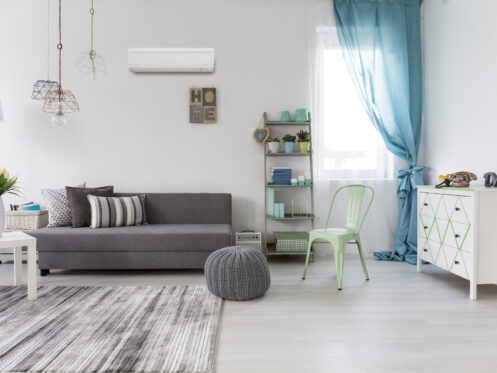When it comes to heating and cooling your home efficiently, two popular options include ducted and ductless mini-split systems. Both have merits and drawbacks. Understanding their unique features can help you make an informed decision for your home. Let’s delve into the pros and cons of each system to help you determine which one might be the best fit for your specific needs.
Ducted Mini-Splits
Pros
Whole-House Comfort ducted mini-splits are designed to cool or heat your entire home. With a network of ducts distributing air to different rooms, you can achieve consistent comfort levels throughout your living spaces. This comprehensive cooling and heating capability are especially advantageous for larger homes or multi-story properties where maintaining a uniform temperature can be challenging.
Aesthetic Appeal
The indoor units of ducted mini-splits remain hidden within ceilings or walls, leaving only vents visible. This discreet installation preserves your home’s interior aesthetics and keeps the equipment out of sight, making them a popular choice for homeowners who prioritize a clean and seamless look.
Customizable Zones
Ducted systems may offer the option to create distinct zones in your home, allowing you to control the temperature independently in different areas. This feature can help save energy and increase comfort by avoiding the wasteful cooling or heating of unused rooms. For instance, you can set higher temperatures in less frequently used spaces like guest rooms, attics, or basements, while maintaining a comfortable temperature in frequently occupied areas.
Cons
Ductwork Complexity
One of the major challenges with ducted mini-splits is the installation of ductwork. This process can be labor-intensive and may require significant modifications to your home’s structure. Moreover, leaky or poorly insulated ducts can lead to energy losses and reduced system efficiency. Routine maintenance is necessary to ensure the ducts remain clean and properly sealed.
Higher Installation Costs
The process of installing ductwork can be more expensive than setting up ductless mini-splits. If your home lacks existing ducts, the installation costs can escalate considerably, potentially making ducted systems cost-prohibitive for some homeowners.
Energy Loss
Ducted systems are more susceptible to energy losses due to leaks, inadequate insulation, or long duct runs. This may result in reduced efficiency and higher utility bills. Regular inspection and maintenance are essential to identify and address potential energy losses due to leakage or corrosion.
Ductless Mini-Splits
Pros
Easy Installation
Ductless mini-splits are relatively easy to install, requiring only a small hole to connect the indoor and outdoor units. This makes them ideal for retrofitting older homes or spaces without existing ductwork. The straightforward installation process can significantly reduce labor costs and time, making them a practical option for quick and efficient HVAC upgrades.
Energy Efficiency
Ductless systems are highly energy-efficient since they eliminate the energy losses associated with ductwork. Each indoor unit operates independently, allowing for targeted cooling or heating in specific areas. With zoned heating and cooling, you can avoid wasting energy on unoccupied rooms, potentially saving energy.
Zoning Flexibility
Ductless mini-splits offer excellent zoning capabilities, allowing you to create personalized comfort zones within your home. Each unit can be controlled separately, providing greater control over energy usage and individual comfort preferences. Additionally, some ductless systems come with advanced features like programmable timers and smartphone connectivity, further enhancing their usability and efficiency. Here are additional reasons to choose ductless mini-splits.
Cons
Limited Coverage
While ductless mini-splits are great for zone-based temperature control, they might not be suitable for whole-house cooling or heating, especially in larger homes. Multiple indoor units may be needed for optimal comfort throughout the residence. This can impact the aesthetic appeal, as the indoor units will be visible in each zone.
Visible Indoor Units
Unlike ducted mini-splits, the indoor units of ductless systems are visible and mounted on walls or ceilings. Although modern designs are sleek and discreet, some homeowners may still find them aesthetically less appealing. Proper placement and consideration of interior design can help mitigate this concern.
Noise Levels
Although advancements have been made in reducing noise, some ductless mini-split models can still generate more sound than ducted systems. Ensure to choose a unit with lower decibel levels if noise is a concern. For sensitive sleepers or quiet environments, this factor may warrant careful consideration.
Get in Touch With Professionals Today!
Are you tired of battling the unpredictable Texas weather? Look no further than Texas Pride Heating & Air for all your cooling, heating, and indoor air quality needs. Our team of expert technicians is dedicated to providing top-notch services to keep your home comfortable year-round. From efficient air conditioning installations to reliable heating repairs, we’ve got you covered.
But that’s not all! We also specialize in insulation and ventilation services, ensuring your home remains energy-efficient and your indoor air quality is fresh and clean. If you are wondering more about ductless mini-split systems, we are the ones to call.
If you’re in Keller or the surrounding areas, don’t wait another day to experience the comfort and peace of mind you deserve. Contact Texas Pride Heating & Air today and schedule a consultation.








